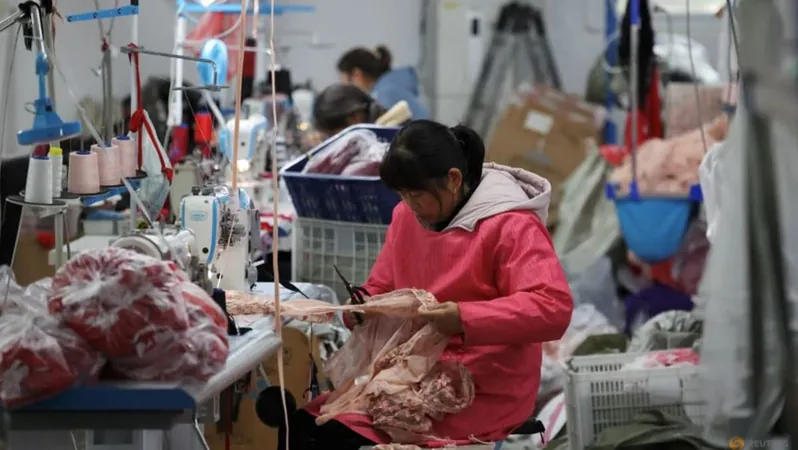
China's Economy: Manufacturing Slows While Services See an Uplift Amid Political Uncertainties
2024-12-31
Author: Nur
BEIJING:
China's manufacturing sector experienced minimal growth in December, while the services and construction industries showed signs of recovery, according to an official survey released on Tuesday, December 31. The National Bureau of Statistics (NBS) reported that its purchasing managers' index (PMI) fell to 50.1 in December from 50.3 a month earlier. Although this figure remains above the crucial 50-point threshold, indicating growth, it fell short of the anticipated 50.3 according to a Reuters poll.
Despite an economy valued at $18 trillion struggling to rebound from the pandemic effects due to weak consumer spending and a lingering property crisis, recent fiscal and monetary policies from the government aim to stimulate growth. Policymakers are particularly focused on revitalizing the real estate market, a key area that has been a drag on the economy.
Improved domestic consumption is expected to aid manufacturers, especially as a global economic slowdown looms and potential new tariffs from US President-elect Donald Trump hang in the balance. Xu Tianchen, a senior economist at the Economist Intelligence Unit, noted, "The worst part of overcapacity seems to be over, businesses are receiving more orders." However, he cautioned that a tapering off of stimulus efforts could jeopardize this fragile recovery.
The manufacturing PMI’s new orders sub-index improved, climbing to 51.0 in December, its highest point in eight months. Conversely, other indices related to new export orders, employment, and factory prices, remained in negative territory, indicating persistent challenges ahead. November's mixed industrial output and retail sales data further highlighted the difficulty Beijing faces in achieving a sustainable recovery.
Government advisers are suggesting an economic growth target of around 5% for the coming year, along with a stronger focus on consumer-centric stimulus measures. On a more positive note, the non-manufacturing PMI, which encompasses services and construction, rose to 52.2 this month, significantly up from 50.0 in November, largely due to growth in financial services, telecommunications, and travel sectors.
After the latest PMI data was released, China's blue-chip CSI300 index saw a decline of 0.6%, while Hong Kong's Hang Seng index recorded a modest increase of 0.35%. Financial analysts from Nomura expressed caution, indicating that it might be premature to claim that recent support measures, such as a consumer goods trade-in scheme and relaxation of property purchase restrictions, have sufficiently stabilized the economy.
With Trump signaling intentions to implement a 10% tariff on Chinese goods over fentanyl-related concerns, along with a previous campaign promise of tariffs exceeding 60%, the economic landscape for China's exporters may soon face further pressure.
Recent commitments from Chinese policymakers at a meeting earlier this month include intentions to expand the budget deficit, issue additional debt, and ease monetary policy as they work to bolster economic growth. Meanwhile, the World Bank published optimistic adjustments to its growth forecasts for China in 2024 and 2025, cautioning nonetheless that existing challenges like low consumer confidence and ongoing property sector struggles will continue to affect economic prosperity.
The Caixin private sector factory survey is scheduled for release on Thursday, with analysts predicting a slight uptick to 51.7. Overall, the December composite PMI, which combines both manufacturing and services activity, increased to 52.2, reflecting a positive shift from the previous month's performance. Gabriel Ng, an assistant economist at Capital Economics, asserted, "Increased policy support towards the end of the year has provided a near-term boost to growth. However, the longevity of this boost remains in question due to unresolved structural issues and potential international trade tensions."
Stay tuned as the situation develops, and see how China navigates these turbulent economic waters!



 Brasil (PT)
Brasil (PT)
 Canada (EN)
Canada (EN)
 Chile (ES)
Chile (ES)
 Česko (CS)
Česko (CS)
 대한민국 (KO)
대한민국 (KO)
 España (ES)
España (ES)
 France (FR)
France (FR)
 Hong Kong (EN)
Hong Kong (EN)
 Italia (IT)
Italia (IT)
 日本 (JA)
日本 (JA)
 Magyarország (HU)
Magyarország (HU)
 Norge (NO)
Norge (NO)
 Polska (PL)
Polska (PL)
 Schweiz (DE)
Schweiz (DE)
 Singapore (EN)
Singapore (EN)
 Sverige (SV)
Sverige (SV)
 Suomi (FI)
Suomi (FI)
 Türkiye (TR)
Türkiye (TR)
 الإمارات العربية المتحدة (AR)
الإمارات العربية المتحدة (AR)